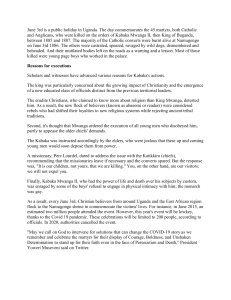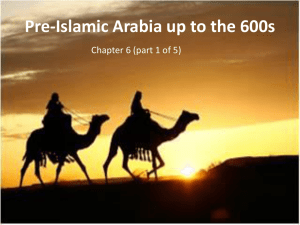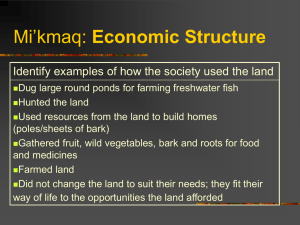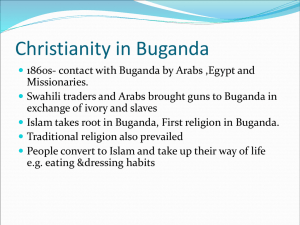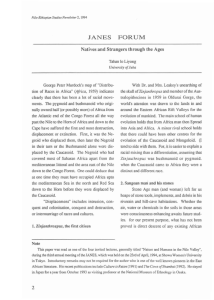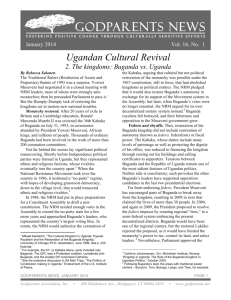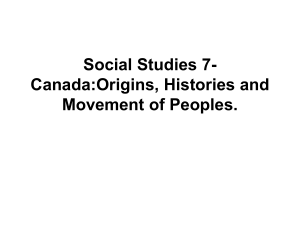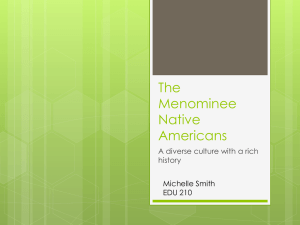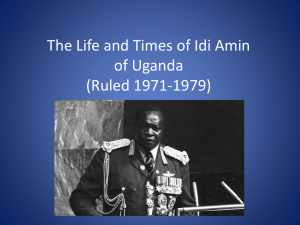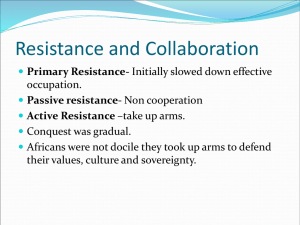A History of Uganda - EWB
advertisement
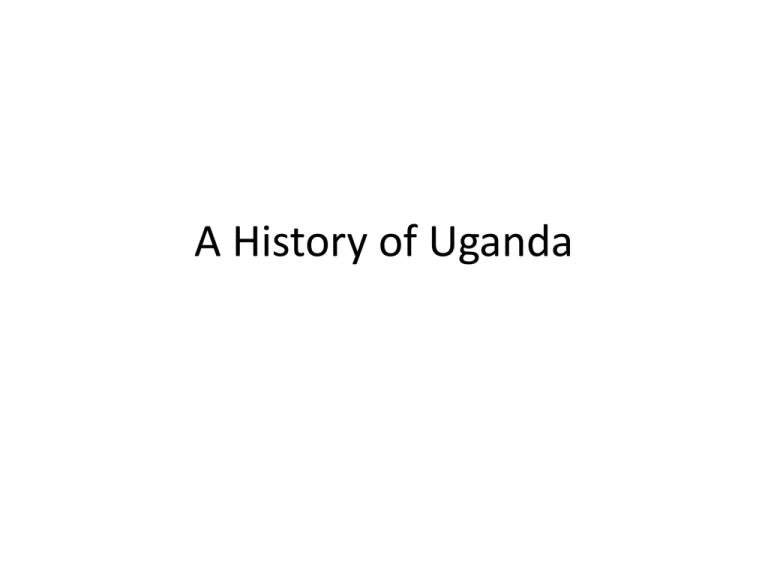
A History of Uganda Course Overview • • • • • • • • Notes Uganda: The Basic Facts Before European Contact The Colonization Period World War I The Interwar Years and World War II Post World War II and Independence Obote, Amin, and Museveni Notes • • • • • • Used 2 texts Not a historian Hard to combine Not my research Focus on Buganda Somewhat skimpy information on recent times – and little from the 2000s on Uganda: The Basic Facts • • • • Kingdom map General location Overview of geography and climate The Ugandan border, as in many post-colonial nations, is the invention of European colonizers. • Unusually, however, is that the border corresponds to ancient kingdoms and political regions; it just smushed them all together. The Emergence of Kingship In the Inter-lacustrine Region Clans • • • • • • • Combine kinship, exogamy, shared symbols, & rules of solidarity Members dispersed throughout the country Clans do not consist of a true genealogical imprint Social identities that allow one to be situated in relation to others, to find friends everywhere & benefit from their hospitality & support Differs in form in different countries Largely similar across the inter-lacustrine region; the exception is Buganda Buganda: – – – – • • • • • • Between 40 and 50 clans – ebika Subclans – masiga Major lineages – mituba Minor lineages - enyiriri Fulfill and integrating function For a long time, the fundamental basis for identity Prominence of the Lungfish Clan (Mmamba clan) – holds many ritualistic & political positions – canoe fleet admiral was from the Mmamba Clan; current Kabaka is from the Mmamba Clan; also Nyika Victor Clans tied to the monarchy / central power Bataka - clan heads – had a protective function, especially in regards to property; as clans dispersed, this became less real Clan sanctuaries Clan Names and Totems • Some names: – – – – – • • • • • Nkima – Red-tailed Monkey Mmammba – Lungfish Nte – Cow Ffumbe – Civet Cat (Walusimbi) Nseenene – Grasshopper Clan totems – primary & secondary Clan prohibitions Clan traditional roles Clan mottoes Last name reflects one’s clan: Namutebi belongs only to women of the Mmammba Clan • (First name often denotes whether one is Catholic, Protestant, or Muslim; Old Testament and Italian names tend to be Catholic; New Testament & British names tend to be Anglican; etc.) The Cwezi Myth • Cwezi myth – similar origin stories amongst peoples of the inter-lacustrine region • Archaeological evidence the emergence of political poles or centers between the 11th and the 16th centuries at one point, some sort of somewhat cohesive political identity • 18th century – Bunyoro declines & Buganda expands The Bugandan Origin Story • Buganda origin myth – Kintu – Placed at the head of around 20 sovereigns – That would place him around the beginning of the 13th century • See Chretien Relationship Between the Clans and the Kabaka • • • • • • • • • • • • • • • • “…the external origin of these two founders – the sky for Kintu and Kitara for Kimera – instead affirms the superiority of kingship, at the kabaka level, over the power of the clans.” “…kingship emerged through a compromise between a new authority of a strongly religious nature, and a network of influential clans.” Different characters in the origin myth represent different clans Every new kabaka was proclaimed “father of the clan chiefs [sebataka]” Certain clans had roles in the enthronement ceremony (Lungfish (Mmamba), Pangolin, Mushroom, Cercopith Monkey [Nkima = Tim] & Colobus Monkey); other traditional roles related to the monarchy When a kabaka is enthroned, he is “slowly infused” with the force of his father under the supervision of the clan ritualists Less reliance on clans as time goes by Each kabaka belongs to his mother’s clan (opposite for the rest of society), so as to share power, at least symbolically, amongst the different clans (remember, exogamy = you can’t marry someone from your own clan) Most clans in Buganda have had a turn as the Queen Mother / Kabaka’s clanship Ceremonies stooped in the 18th century under the Kabaka Namugala Replaced with an initial ritual honoring Kintu on the ritual hill Naggalabi & managed by the Lungfish and Pangolin Clans Milton Obote, the President (read: dictator) in the 1980s abolished the monarchies Came into use again in 1993 when the monarchy was restored “…the royal institution was everywhere embedded in a network that controlled the supernatural, managed by clans whose history went back…” (Chretien, 132) Religion based on Buganda’s version of the Bacwezi cult bolstered kingship but also could be used as grounds to objecting to bad behavior (aka, it was a political “currency”) Later on, after colonization, Buganda’s Christianized elites envisioned the Kabaka as a secular power, and this idea for many years eclipsed the religious dimension of this institution (153) The Formation of Monarchial States The Shores of Lake Victoria: The Rise of Buganda The Functioning of the Monarchy: the Political Capitals Managing the Kingdoms: Territories, Commands, and Prestations Colonial Trusteeships and Reconstructions of Tradition The Search for the “Sources of the Nile”: A British Endeavor The Christian Missions: Dreaming of a Second Ethiopia The Colonial Partition: Diplomacy, Cartography, and Local Politics Opening to the World and an Ecological and Demographic Crisis The Ugandan Model: Indirect Rule Uganda: “The Pearl of the Empire”? 1914-1939 World War I and the Invention of Mandates Dissent and Buganda Separatism The Closer Union Proposal The Rise of Nationalism and Independence 1939 - 1963 Regained Independence and the Obsession with Genocide In General Uganda: A Republic and Its Kingdoms 1953: The Kabaka Crisis Museveni’s Regime Post-WWII Trends in East Africa “Recolonization” World War II and East Africa Popular Discontent in Buganda The “Kabaka Crisis” National Politics & Buganda Separatism First Elections Towards Independence Lukiko Elections in Buganda General Elections of 1962 The Colonial Economy Independent East Africa 1960s to 1990s Trends Independence & Dependency Economic Dependency European and Asian Minorities Closer Union (Again) Dominance of Kenya The East African Community (EAC) In Summary Cooperation & Conflict w/ Buganda Political Turmoil & the Kabaka’s Downfall Uganda’s New Republic Obote’s Fall and the Amin Dictatorship Post-Amin Uganda Uganda’s Foreign Affairs
